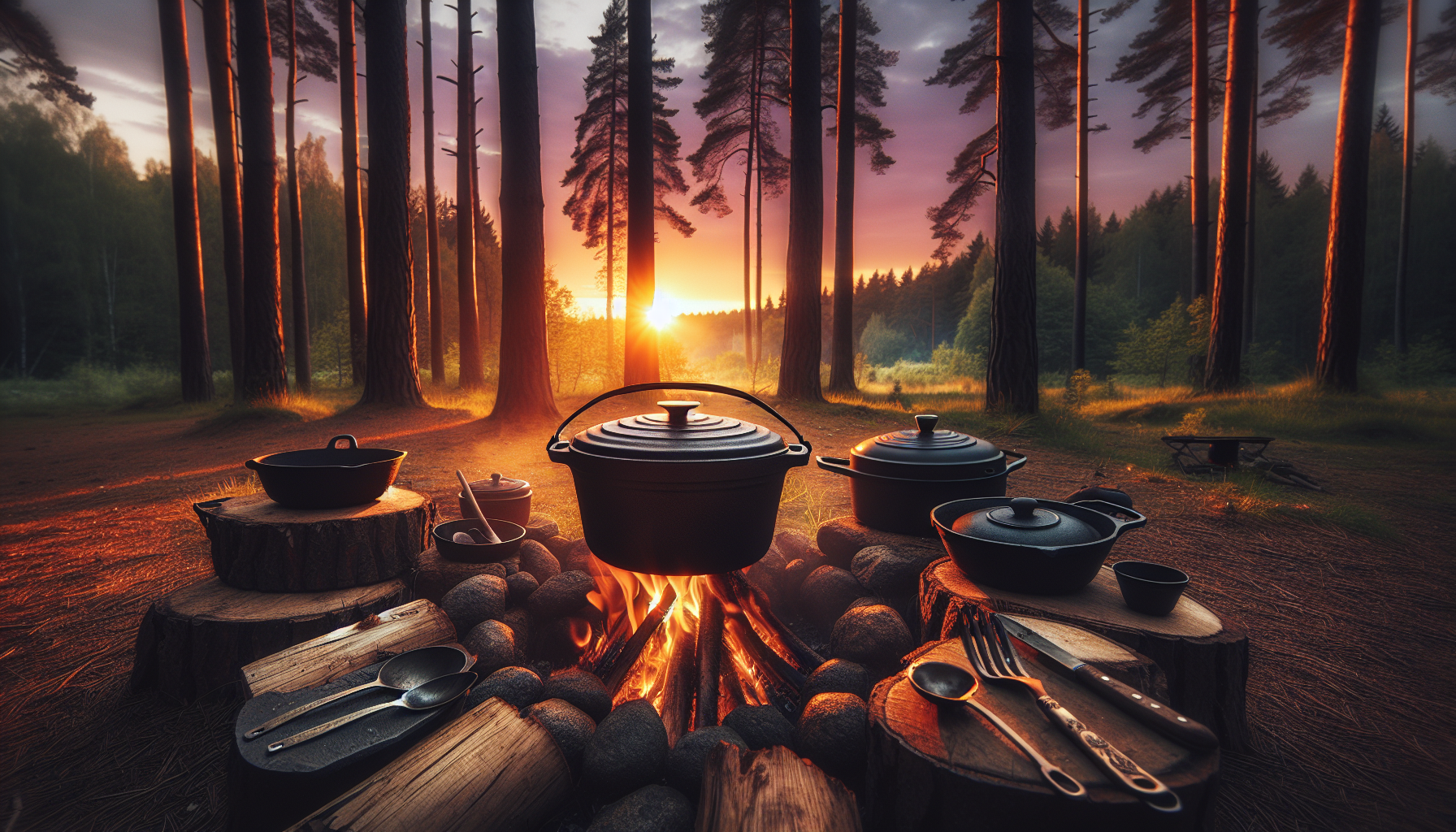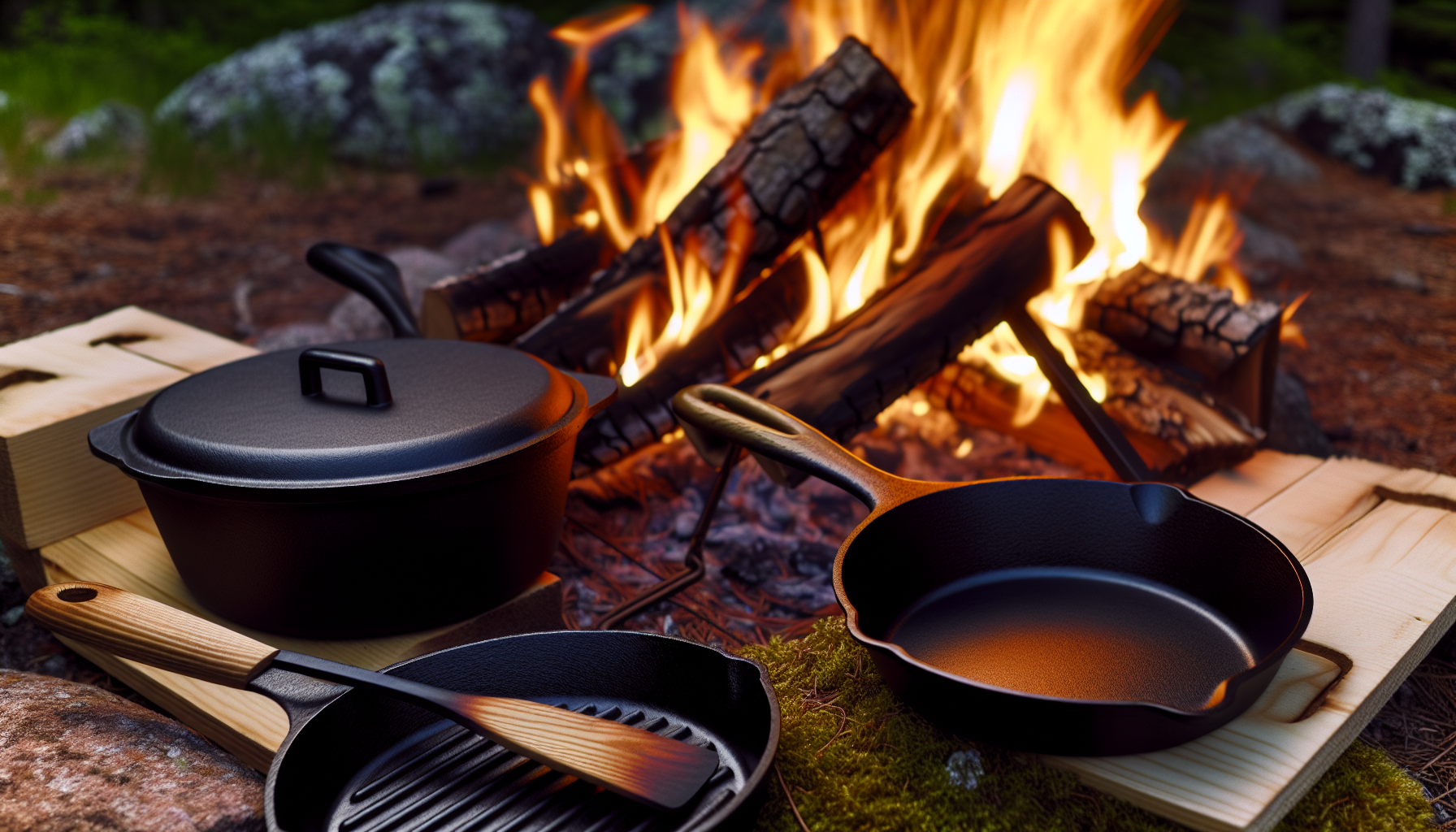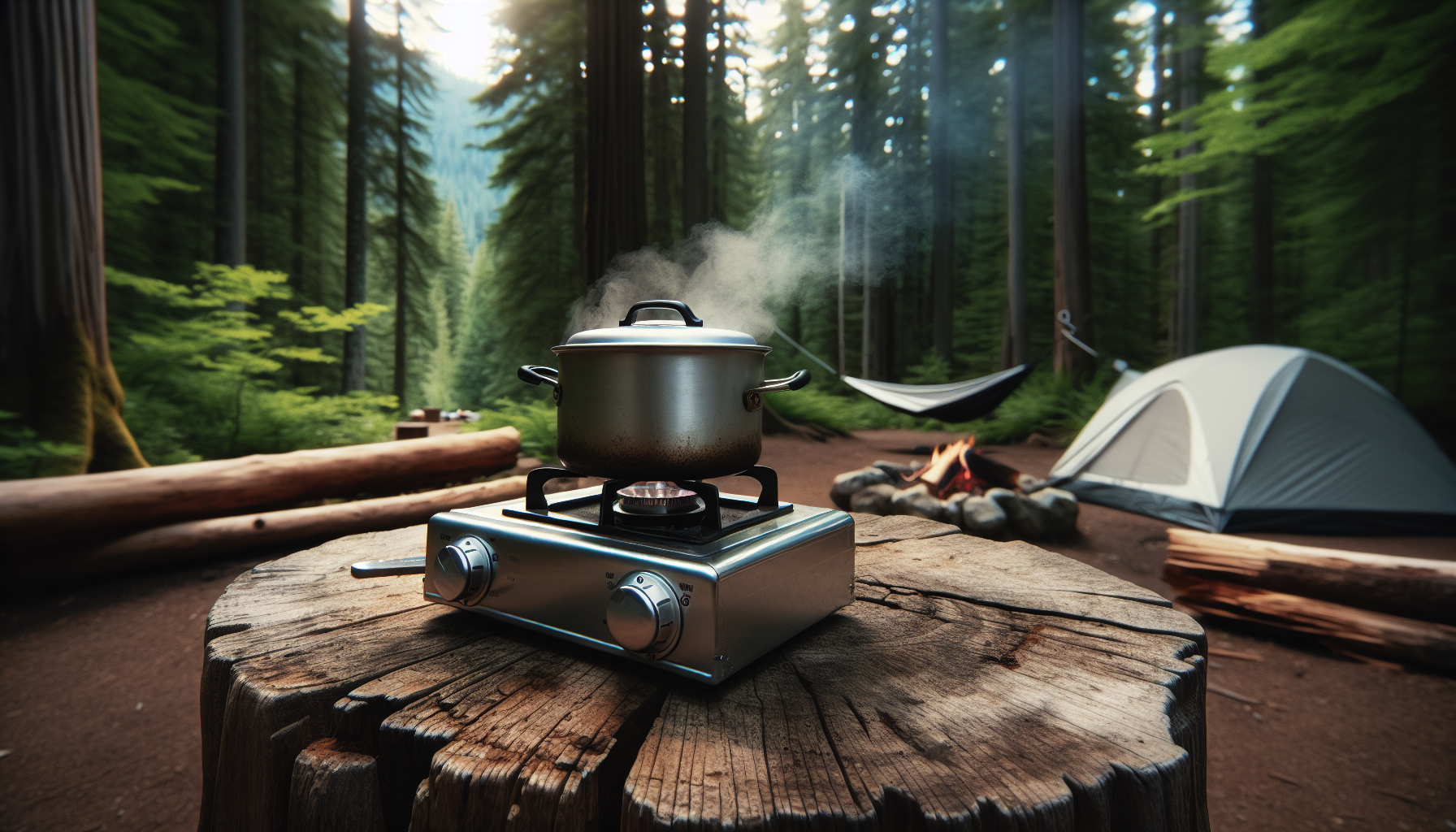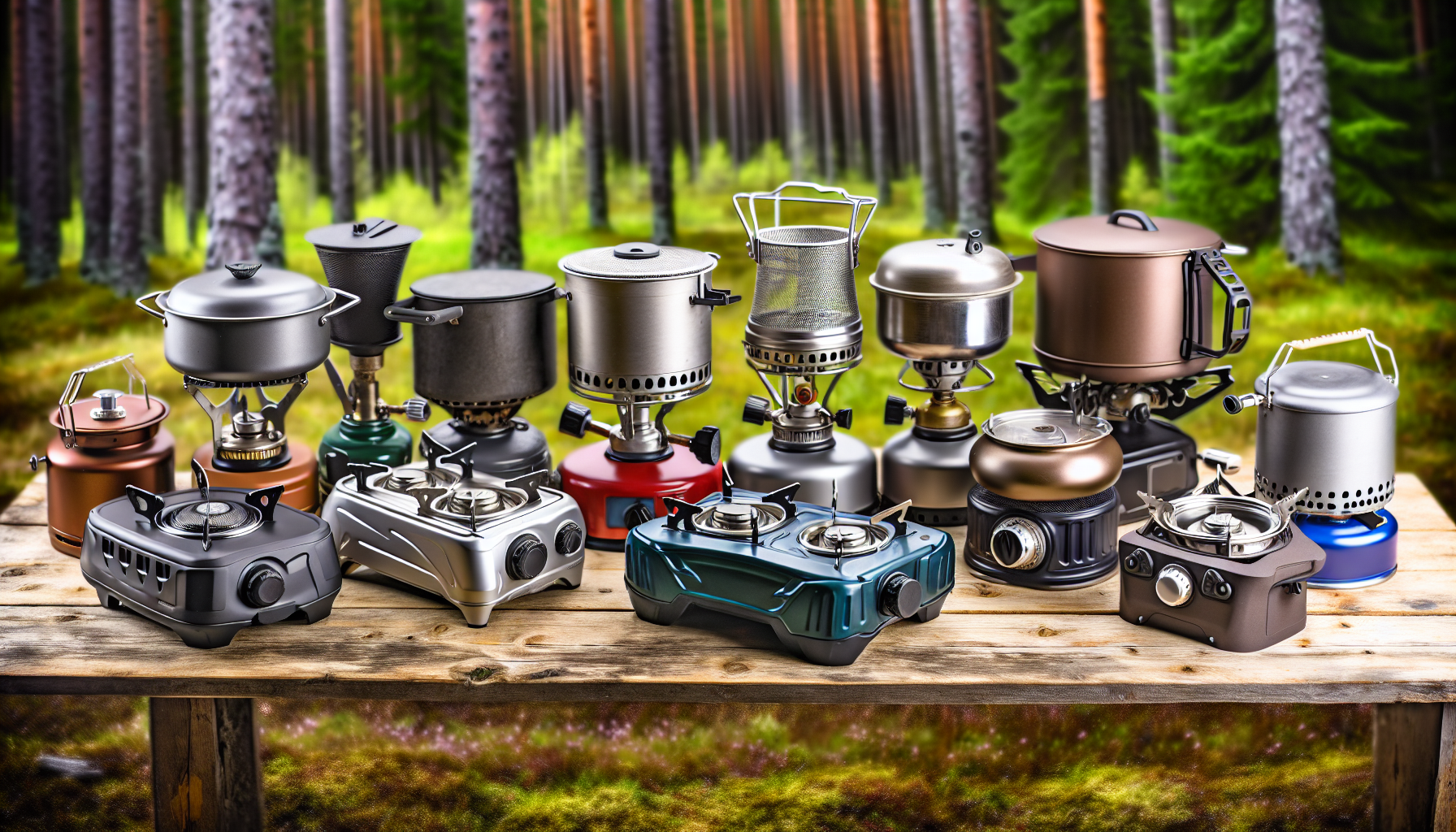Choosing Your Campsite Companion: Campfire Cooking vs Portable Propane Stove While Camping
If you’re contemplating campfire cooking vs portable propane stove while camping, you’re not alone.
Each has its allure: the smoky flavor of a wood fire or the quick convenience of propane.
Our article cuts through the noise, giving you the facts you need for an informed decision.
Setup, taste, cook time—find out which method will elevate your camping experience, without endorsing one over the other prematurely.
Key Takeaways
Campfire cooking is traditional, creates a unique flavor, and enhances the nature experience, while it requires building a proper fire, monitoring the food carefully, and using specific cookware like cast iron.
Portable propane stoves offer modern convenience with compact, lightweight design, precise temperature control, and are ideal for quick, controlled cooking, especially during adverse weather conditions.
Choosing between campfire cooking and a propane stove depends on personal preference, type of camping, and desired outdoor experience; both methods have unique advantages and can be combined for a versatile approach to campsite cooking.
Campfire Cooking: Embracing the Tradition

Campfire cooking is as old as humanity itself. Early humans kindled fires and tossed raw food into them almost two million years ago, giving rise to the oldest and most traditional form of cooking. This form of cooking is quite different from using a propane gas stove and requires a different set of skills and tools.
Correctly building your fire and having the appropriate gear are crucial steps in preparing your campfire for cooking. Here are some tips to help you:
Use aluminum foil to wrap food and cook it directly in the coals.
Set up a grill over rocks or wetted green logs to cook food directly on the grill or in cookware like a dutch oven.
Carefully monitor and turn your food to ensure even cooking.
Use a thermometer to check the temperature of your food.
By following these tips, you can have a successful cooking experience over a campfire.
Despite the need for some skills and techniques, campfire cooking has a certain charm. It connects us to our ancestors, allows us to embrace the great outdoors, and adds a smoky flavor to our meals that’s impossible to replicate on a propane grill. Moreover, there’s something inherently satisfying about cooking meals over an open fire, under the vast open sky, surrounded by the tranquility of nature.
Advantages of Campfire Cooking
Cooking over a campfire is a unique experience that offers several benefits.
The natural smoke and heat from the fire give the food a distinct flavor, making cooking meals a memorable part of camping trips.
This method of cooking, which is quite different from using a propane stove, adds a unique and nostalgic flavor to the food, enhancing the overall camping experience.
I personally love it but it does take time. So depending on the type of camping style, I go on, I make the decision for slow and leisurely cooking vs. quick meals vs. cooking with family and friends.
Campfire cooking also adds to the whole camping vibe by:
keeping you warm when it’s chilly
making your food taste extra special
adding to the whole nature experience
being economical as you can use fallen branches and twigs that are easy to find
allowing you to cook simple foods like hot dogs, which are a classic campfire favorite.
Campfire Cooking Techniques
Like any other cooking method, campfire cooking also has its techniques. The main ways to cook over a campfire are setting up two fires—one for cooking and one for keeping embers, and cooking right over the fire with some embers for faster searing. A successful campfire cooking experience hinges on the possession of the right camping cookware.
To keep the heat in check while cooking on a campfire, you can flip the food often, keep an eye on the temperature with a thermometer, and use aluminum foil for certain dishes to control the heat and keep things juicy. A cast iron skillet is also a great option for campfire cooking, as it retains heat well and cooks food evenly.
Whether you’re planning to cook meat or veggies over a campfire, there are various techniques that can make your next camping trip even more enjoyable.
Essential Campfire Cookware

In the realm of campfire cooking, possessing the right cookware can significantly change the game. Some essentials you’ll need for campfire cooking are:
A grill grate
A cast iron pan
Metal tongs
Heat-resistant gloves
The best materials for campfire cookware are stainless steel, aluminum, and cast iron. They can withstand the heat of a campfire and are highly durable, making them perfect for cooking in the great outdoors.
Not only is having your campfire cookware important, but caring for it is equally vital. To keep your cookware in good shape, clean it thoroughly after use and store it correctly. For cast iron pans, soak them before using and wash them once or twice a year with hot water and a non-metal brush. This helps to maintain the pan’s seasoning and prevents rusting.
Brands like Stanley are known for their quality campfire cookware products like the Stanley Even-Heat Camp Pro and Stanley Adventure Base Camp 4. These products can help you achieve that desired smokey flavor when cooking over a campfire.
Portable Propane Stove: The Modern Convenience

While the tradition of campfire cooking has its charm, the modern convenience of portable propane stoves cannot be overlooked. Here are some advantages of using portable propane stoves:
They are compact and lightweight, making them easy to transport.
They offer precise temperature control, allowing you to cook your food exactly how you want it.
They are highly economical, saving you money on fuel costs.
The operation of a portable propane stove is quite simple. You simply turn on the burner to let a bit of fuel flow through and collect in the priming pan. These stoves are handy for cooking and easy to take with you wherever you go. There are several types of portable propane stoves available in the market, such as:
Canister-top camping stoves
Remote canister camping stoves
Stove systems
Wood-burning camping stoves
Alcohol stoves
Liquid and multi-fuel stoves
When choosing a portable propane stove for camping, consider how much cooking you’ll be doing and the duration of your trips. Also, check out how much space you’ll have for cooking. Propane is a reliable choice, and don’t forget to consider the weight and packability of the stove.
Benefits of Portable Propane Stoves
Portable propane stoves come with several benefits that make them an ideal choice for campers. Here are some of the benefits:
They provide the flexibility to use different fuel options
They facilitate easy ignition and flame control
They prove to be economical
They work with different fuel canisters
They are durable
They cook food efficiently outdoors
Portable propane stoves make cooking at the campsite a breeze with their convenience, adaptability, and precise temperature control. Additionally, their multiple burners allow for cooking different dishes simultaneously, and their compact, lightweight design makes them easy to carry and set up. Furthermore, propane stoves make camping safer by having:
a controlled flame
stable cooking surfaces
no sparks or embers
easy ignition and shutdown mechanisms with built-in safety features
However, it’s important to note that while using propane and butane doesn’t really affect the ozone layer, manufacturing these fuels takes up a lot of energy.
Choosing the Right Camping Stove

Selecting the appropriate camping stove has the potential to greatly enrich your camping experience. The market offers a variety of options like:
Canister camping stoves
Standard propane campground stoves
Canister backpacking stoves
Liquid fuel backpacking stoves
Wood stoves
Pellet stoves
Alcohol stoves
Tablet stoves
To pick the right camping stove, consider the type of camping you’re planning. Here are some factors to consider:
For backpacking, canister stoves are a great choice as they’re easy to use and require minimal maintenance.
If you’re car camping or doing base camping, think about how much cooking you’ll be doing and the duration of your trip.
Also, consider the BTU rating of the stove depending on your needs.
For instance, a minimum of 10,000 BTU per burner is recommended for group camping scenarios. The burner count also matters. Having two burners is pretty handy for cooking up a storm when you’re out with friends or family.
Safety Tips for Propane Stove Use
When using propane stoves, safety takes precedence. Here are some important safety tips to keep in mind:
Make sure you are outside or in a well-ventilated area
Utilize the correct fuel
Inspect the stove before each use
Place the stove on a flat surface
Employ suitable cooking gear
Maintain the cleanliness of the stove
It’s essential to never use the stove inside a camper, tent, or garage and not to use it if it’s not working properly.
To safely light the stove, follow these steps:
Press the burner’s control knob to release gas.
Ignite the burner quickly.
Keep holding the knob for another 5 to 10 seconds to ensure the flame stays stable. This way, you ensure the valve opens properly and the gas is being lit securely.
While not in use, the stove should be kept in a cool, dry place, away from direct sunlight, to prevent overheating and potential risks.
Comparing Campfire Cooking and Propane Stoves

While both campfire cooking and propane stoves have their merits, they offer different experiences and cater to different needs. Campfire cooking is about the classic open flame vibe, but it can be unpredictable and take longer to cook. On the other hand, propane stoves provide a clean and steady burn for faster and more controlled cooking, especially in rough weather.
Different requirements are associated with setting up for campfire cooking compared to using a portable propane stove. For campfire cooking, you need to start the fire about an hour before to get the coals hot, while a propane stove requires a quick setup once unpacked and connected to the propane tank. Cleanup also varies; campfire cooking requires scrubbing with biodegradable soap and a stiff brush, while a propane stove just needs a wipe down with a sponge, rinse, and dry.
Portability is another factor to consider. Propane stoves are designed to be compact and lightweight, making them easier to carry around. But campfire cooking gear, although heavier and bulkier, offers that classic outdoor cooking vibe.
Cooking Styles: Traditional vs Modern
Choosing between traditional campfire cooking and modern propane stove use largely depends on your personal preference and the type of cooking you plan to do. Traditional campfire cooking techniques like setting up two fires and using a grill grate to cook over open flames can make a variety of meals. In contrast, modern propane stove cooking focuses on picking the right burner for the pot, matching the burner to the pot size, and using modern cookware that’s good at conducting and retaining heat.
The taste of food also varies between the two methods. Here are some differences:
Food cooked on a campfire gets that smoky flavor from the wood burning, while food cooked on a propane stove doesn’t have that smoky taste.
Certain foods require precise temperature control, like pan frying or simmering, making them better suited for propane stove cooking.
But if you want that real campfire taste, cooking over a campfire is a great choice, especially for small amounts of food.
Propane stoves are better for larger meals and offer more control over the heat.
Convenience Factors: Setup, Cleanup, and Portability
Setting up for campfire cooking requires some planning and prep work. You need to start the fire about an hour in advance to get the coals hot. Cleanup involves using biodegradable soap and a stiff brush to scrub everything clean.
On the other hand, a propane stove requires a quick setup once you unpack it and connect it to the propane tank. Cleanup is also easier as you just need to wipe it down with a sponge, give it a good rinse, and let it dry.
The Outdoor Experience: Ambiance and Social Aspects
The choice between campfire cooking and a propane stove also impacts the overall outdoor experience. A campfire not only provides heat and light but also adds a warm and cozy ambiance to the camping site. It brings people together, fostering a sense of community and helping everyone bond, which is a significant part of the outdoor experience.
Campfire cooking is a tradition where people come together to cook, share stories, and relax. It’s all about that social vibe. On the other hand, cooking on a propane stove can be a more solitary activity, but it allows for more control over the cooking process and is ideal when cooking for larger groups or in adverse weather conditions.
Best Recipes for Campfire Cooking and Propane Stoves
Regardless of whether you opt for campfire cooking or a propane stove, a multitude of recipes are available for you to experiment with, enhancing your camping trip. Some popular camping recipes include:
Campfire nachos
Shrimp boil foil packets
Easy chickpea curry
Sausage breakfast sandwiches
The possibilities are endless.
Campfire Favorites
When it comes to campfire cooking, some favorite recipes include lentil sloppy joes, breakfast muffins, and skewered chunks of chicken, steak, or tofu with vegetables for a colorful meat and veggie rainbow over the flames. These recipes not only taste great but also enhance the overall camping experience.
Propane Stove Specialties
Cooking on a propane stove offers a different but equally delightful experience. Some of the best dishes you can prepare using a propane stove include:
Shrimp boil foil packets
Easy chickpea curry
Sausage breakfast sandwiches
Peanut butter chocolate chip pancakes
Cast iron fish
These dishes, including french toast, can be prepared quickly and efficiently, making them perfect for camping trips.
Adapting Your Cooking Style to Your Camping Needs
The decision between campfire cooking and propane stoves is largely contingent on your individual preferences and camping requirements. You can mix it up by using a propane stove for things that require quick and controlled cooking, like breakfast or boiling water, and then using the campfire for things that taste great with that traditional smoky flavor, like grilling meat or roasting marshmallows.
Factors to Consider
When deciding upon a cooking method for camping, several factors must be taken into account. These include:
The location of your campsite
What kind of camping you’re doing
What meals you want to make
The availability of firewood
Certain types of firewood like oak or hickory are great for grilling as they burn hot and add flavor.
Combining Both Methods
To enjoy the benefits of both methods, you might want to consider a combination of campfire cooking and propane stove use. This can provide a versatile cooking experience that caters to a variety of tastes and preferences. To do this efficiently, have a clear plan of what foods will be cooked with each method and organize ingredients and cookware beforehand. Quick switches can conserve fuel and minimize impacts on the environment.
Final Thoughts
In conclusion, both campfire cooking and portable propane stoves offer unique benefits and experiences.
Choosing between them depends on a number of factors, including your personal preference, camping needs, and the kind of food you wish to prepare.
By understanding the advantages and limitations of each method, you can make an informed decision that enhances your overall camping experience.
Whether you’re roasting marshmallows over an open fire or making breakfast on a propane stove, remember that camping is all about enjoying the great outdoors and creating lasting memories.
Frequently Asked Questions
Can you use a portable gas stove in a tent?
Using a portable gas stove in a tent can be dangerous due to the release of odorless and invisible carbon monoxide, posing a risk to your safety.
Which stove is best for camping?
I’d recommend looking for camping stove reviews to find the best one for you.
Is a camping stove better than a campfire?
Yes, a camping stove is usually better than a campfire because many parks prohibit fires, and stoves are generally much safer.
What are some easy recipes to make on a propane stove while camping?
You can make delicious campfire nachos, chicken tzatziki skewers, shrimp boil foil packets, easy chickpea curry, and sausage breakfast sandwiches on a propane stove while camping. Enjoy your meals!
What are the benefits of cooking over a campfire?
Cooking over a campfire adds a unique, nostalgic flavor to the food and enhances the overall camping experience by providing warmth and a social gathering spot. Enjoy!



